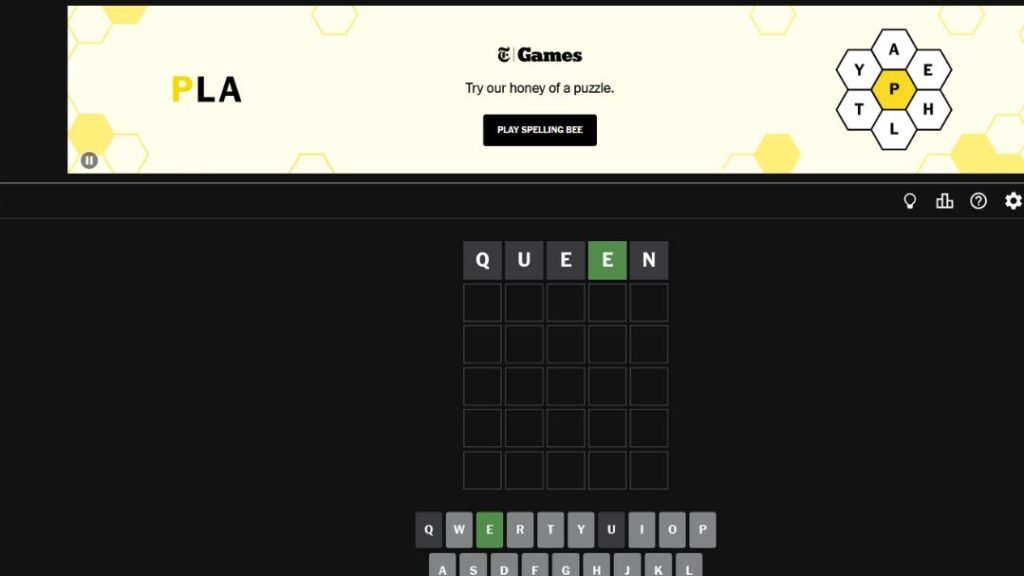Wordle Today Answers: A Deep Dive Into the Internet Favorite Word Puzzle
The Wordle game has taken the digital world by storm, becoming a global phenomenon among casual gamers, puzzle lovers, and social media users alike. This simple yet captivating word puzzle game has captured the attention of millions around the globe, offering a daily dose of linguistic challenge and entertainment. In this comprehensive article, we will explore the history, mechanics, features, popularity, and impact of the Wordle game, along with tips and strategies to master it.

Table of Contents
- Introduction to Wordle
- History and Origin of Wordle
- How to Play Wordle
- Game Mechanics and Rules
- Why Wordle Became So Popular
- The Role of Social Media
- Acquisition by The New York Times
- Wordle’s Impact on Language and Learning
- Variants and Spin-offs of Wordle
- How to Improve Your Wordle Skills
- Common Strategies and Tips
- The Psychology Behind Wordle
- Accessibility and Inclusivity in Wordle
- Community and Daily Sharing
- Educational Applications of Wordle
- Criticisms and Challenges
- Mobile vs. Desktop Gameplay
- Wordle in Pop Culture
- Future of Wordle
- Conclusion
1. Introduction to Wordle
Wordle is a browser-based word puzzle game that gives players six attempts to guess a five-letter word. With its minimalist interface and intuitive gameplay, it quickly became a daily ritual for many. Players love its simplicity, shareability, and the cognitive satisfaction it brings.
2. History and Origin of Wordle
Wordle was created by Josh Wardle, a software engineer from Wales, in October 2021. Originally designed as a personal gift for his partner who loved word games, it quickly gained popularity after being released publicly. By the end of 2021, it had gone viral, especially on platforms like Twitter and Reddit.
Josh Wardle’s creation was inspired by classic word games like Mastermind and the New York Times Spelling Bee, but with a modern twist. Its simplicity and daily challenge format made it accessible and addictive.
3. How to Play Wordle
Playing Wordle is straightforward:
- The player is presented with six rows and a keyboard.
- They guess a five-letter English word.
- After each guess, the game provides feedback by color-coding the letters:
- Green: Correct letter in the correct position.
- Yellow: Correct letter in the wrong position.
- Gray: Letter is not in the word.
The objective is to guess the correct word within six attempts. There is only one Wordle puzzle per day, creating anticipation and a sense of global community.
4. Game Mechanics and Rules
Wordle’s mechanics are what make it both accessible and challenging:
- Only valid English words are allowed as guesses.
- Feedback after each guess helps players narrow down possibilities.
- Each puzzle resets every 24 hours.
- Players cannot go back and change their guesses.
- No hints or assistance—players rely purely on logic and vocabulary.
This no-frills approach is a big part of Wordle’s charm. There’s no account creation, no ads (in the original version), and no pressure—just pure gameplay.
5. Why Wordle Became So Popular
Wordle’s popularity can be attributed to several key factors:
- Simplicity: Easy to understand and play.
- Daily Limit: One puzzle per day keeps it from becoming overwhelming.
- Shareability: The color-coded results are easily shareable on social media.
- No Paywall: It started as a free game with no ads.
- Mental Stimulation: Appeals to people who enjoy wordplay and logic.
6. The Role of Social Media
One of the biggest catalysts behind Wordle’s rapid growth was its social media presence. The ability to share your results using colored emoji boxes (without spoilers) encouraged daily sharing. This built curiosity and encouraged others to join the fun.
Twitter, in particular, played a key role. Users began posting their scores and discussing strategies, turning Wordle into a viral trend.
7. Acquisition by The New York Times
In January 2022, The New York Times (NYT) acquired Wordle for a price “in the low seven figures.” The NYT saw the potential in Wordle as part of its growing portfolio of puzzle games.
Post-acquisition, Wordle was integrated into the NYT’s Games section but remained free for users. The transition sparked some concerns about difficulty levels and word choices, but the core gameplay remained unchanged.
8. Wordle’s Impact on Language and Learning
Wordle has inadvertently become a tool for improving language skills:
- Vocabulary Expansion: Players learn new five-letter words.
- Spelling Accuracy: Encourages correct spelling and attention to detail.
- Logical Thinking: Requires deductive reasoning and pattern recognition.
Educators have also found ways to incorporate Wordle-like games into classroom learning to make vocabulary building more engaging.
9. Variants and Spin-offs of Wordle
Due to Wordle’s popularity, numerous variants and spin-offs have emerged:
- Quordle: Guess four words at once.
- Octordle: Eight words at once.
- Heardle: Musical version—guess a song from short clips.
- Worldle: Geography-based guessing game.
- Nerdle: Math-focused puzzle involving equations.
- Lewdle: Wordle with adult language.
- Absurdle: The AI tries to prevent you from winning.
These variations explore different themes while keeping the core logic of Wordle intact.
10. How to Improve Your Wordle Skills
Improving at Wordle requires a blend of vocabulary knowledge, strategic thinking, and experience. Here are a few tips:
- Start with a strong opener: Choose a word with common vowels and consonants like “SLATE” or “CRANE.”
- Eliminate unlikely letters early: Use your first few guesses to test as many letters as possible.
- Pay attention to feedback: Use color cues effectively to narrow down possibilities.
- Practice daily: Like any puzzle, practice improves performance.
11. Common Strategies and Tips
Some advanced strategies include:
- Letter Frequency Awareness: Familiarize yourself with common five-letter words and frequently used letters in English.
- Avoid Repeating Letters Initially: Use initial guesses to test new letters.
- Use Elimination: Even a wrong guess provides useful information.
- Save Green Letters: Don’t waste guesses on letters you’ve already confirmed.
12. The Psychology Behind Wordle
Wordle taps into several psychological principles:
- Daily Streaks: Encourages commitment and habit-building.
- FOMO (Fear of Missing Out): Everyone’s playing it, so users don’t want to be left out.
- Reward Loop: The satisfaction of solving the puzzle creates a dopamine hit.
- Social Validation: Sharing success reinforces participation.
These factors make Wordle not only fun but also addictive in a healthy way.
13. Accessibility and Inclusivity in Wordle
Wordle is accessible to a wide audience:
- No registration required
- Simple interface
- Compatible with screen readers
- Color-blind mode: Introduced post-acquisition for better accessibility
This inclusivity has widened its appeal across demographics and age groups.
14. Community and Daily Sharing
The global Wordle community has become part of the game’s culture. From Reddit threads analyzing daily puzzles to Twitter accounts offering tips and memes, Wordle has built a massive following.
Daily sharing has become a ritual for many users, similar to checking the weather or reading the news.
15. Educational Applications of Wordle
Educators are using Wordle in schools to:
- Improve vocabulary
- Teach spelling and phonics
- Promote critical thinking
- Encourage classroom participation
Customized versions of Wordle let teachers input their own word lists, making it adaptable across subjects.
16. Criticisms and Challenges
Despite its popularity, Wordle has faced some criticisms:
- Repetitiveness: Some users feel the format gets stale over time.
- Word Difficulty: NYT’s word choices have been considered harder.
- Time Restrictions: Only one puzzle per day can be limiting.
Nonetheless, the overall user response remains overwhelmingly positive.
17. Mobile vs. Desktop Gameplay
Wordle is a browser-based game and works well on both desktop and mobile devices. However, the experience may vary slightly:
- Desktop: Easier typing, better screen space
- Mobile: Convenient, can be played on the go
There are also unofficial Wordle apps available on mobile platforms, though users are advised to stick to trusted sources like the NYT’s website.
18. Wordle in Pop Culture
Wordle has been referenced in:
- TV shows
- Late-night talk shows
- News articles
- Social media memes
Celebrities, politicians, and influencers have also shared their scores, further fueling its popularity.
19. Future of Wordle
The future of Wordle seems promising:
- Integration into NYT app ecosystems
- Daily leaderboards and competitions
- Educational partnerships
- Merchandise and themed content
As long as the core experience remains untouched, Wordle is likely to retain its loyal player base.
20. Conclusion
Wordle is a shining example of how simplicity and creativity can lead to viral success. What began as a small project between a couple soon became a worldwide sensation, fostering daily engagement, community building, and mental stimulation. Its impact on language learning, pop culture, and digital gaming is undeniable.
Whether you’re a seasoned player or a newcomer, Wordle continues to be a delightful and enriching way to engage with words. Its ability to bring people together through the power of language is what makes it more than just a game it’s a global linguistic phenomenon.






